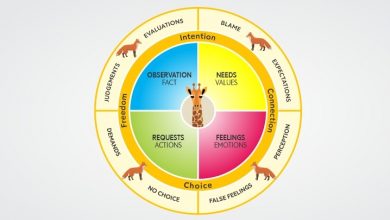Deal with the issue, don’t attack the person
How can we deal with issues or problems head on, without unnecessarily hurting the people involved? How can we differentiate between the person and the problem? What are the results of these two different approaches? Is political correctness always effective, or is there perhaps a more genuine kind of correctness? These questions and more are explored by this article.

Why did I choose this tool? Many times, I have made the mistake of attempting to solve an issue by “attacking those involved”, even though I wouldn’t call it that. And I’ve also seen others do it. The results are generally negative, people feel hurt, lash out, they attack back, the conversation stops and any attempt to communicate or learn anything from the situation is sabotaged. On the other hand, I’ve seen people (including trainers) walking on eggs when giving a training due to fear of offending anyone or provoking any negative reactions, and this can lead to a watered down training that doesn’t really make any difference in either way. For myself I try to use a third way, saying what needs to be said, dealing with issues that need to be dealt with, but in a way that no one feels attacked or demeaned in the process. At first it seems more difficult than the other two approaches I mentioned above, but the results are worth it and it gets easier with practice.
How does this apply to being a trainer? Using this tool can give us confidence as trainers to deal with any potential issues that can come our way, whether in the training process, with our team or with a specific participant. Using this tool can make the difference between preserving the team atmosphere and reach the learning goals, or having everything disrupted by hurt feelings or people being offended. Since I believe we mostly have good intentions, I also believe that when we cause hurt feelings it is mostly because we aren’t aware of other ways to handle the situation. The goal of this article is to offer alternatives.
Main content:
In their best-selling negotiation book, Getting to Yes, Fisher, Ury and Bruce Patton, list the four “principles” of a negotiation strategy they call “Principled Negotiation.” This strategy, they argue, can solve essentially any conflict.”
- “Separate the people from the problem”
- “Focus on interests, not positions”
- “Invent options for mutual gain”
- “Insist on using objective criteria”
For the purpose of this article we will focus on the first principle.
Separate the people from the problem
This means that instead of attacking the people on the other side(s) as they are the problem, you instead deal with the real problem you are both concerned about. This applies both to a problem you may have with your team or training group, as well as to major political or world issues. Most of us know better than to attack someone directly, but there may be times when we do so without even realizing it. For instance, by attacking something that they consider to be part of their identity, or by trying to fix some apparent flaw that we think they have.
The identity is consisted of the elements people feel strongly attached to, whether it’s their profession, their role in life, their personality, their country, their religion, the non-profit organization they belong to or their passion/hobby. None of these elements will necessarily constitute identity, since it varies from person to person what they identify with and describe as “this is so me!”. But whatever they do choose as their identity, for as long as they choose it, will become an unalienable part of them. Therefore, if you attack it, they will feel as if you are attacking them directly.
To avoid hurting people’s feelings unnecessarily, whenever problems are discussed make sure to focus on the problem itself rather than the person or the group of people you assume are responsible for it.
Here are some sentences that show the difference between attacking a person (or a group) and addressing a problem:
Person/group focused
“All psychologists are messed up themselves.”
Issue focused
“Psychologists might benefit from working on themselves, before working with patients.”
Person/group focused
“Refugees are just causing chaos and mayhem.”
Issue focused
“Refugees may need more opportunities to become productive in the countries where they are taking refuge.”
Person/group focused
“You’re always late!”
Issue focused
“We need to be clear and agree on timings and stick to them if we are going to get the job done on time.”
Person/group focused
“How come you can’t see the glaring issue that’s right in front of us?”
Issue focused
“Let me know what aspects of this aren’t yet clear, and I’ll explain it better.”
Fisher, Ury, and Patton point out that conflicts are usually made up of two kinds of problems: substantive problems and “people problems.” Even though it’s easier to blame someone and find a scapegoat for substantive problems, we should refrain from making substantive problems into “people problems”.
When it is a “people problem”, it still requires delicacy and tact so that the other side doesn’t feel attacked and lash out accordingly. They say there are three kinds of ‘people problems’, and all three tend to result in attacks on people instead of the problem. These are (1) differing perceptions, (2) strong emotions, and (3) miscommunication.
- Differing Perceptions:
- Everyone has a reason for thinking, believing and acting the way they do. When perceptions differ, rather then putting down or dismissing the person that has a different perception, it is better to become curious about it and genuinely try to understand it. Here are some questions you can ask and answers you can give to understand and accept a differing perception:
“Can you tell me more about why you feel this way?”
“Were there specific circumstances or events that led you to have this opinion?”
“Interesting, I haven’t thought about it that way. Can you tell me more about it?”
“I don’t hold the same opinion, but I understand why you would and I accept that.”
“If I had the same experiences as you, I would probably have the same opinion/belief.”
Asking for differing perceptions outright:
“Are there any differing opinions on this? I would really like to hear them.”
- Emotions:
- Emotions must be recognized, named, and dealt with directly–not ignored or attacked. So, if someone is afraid or angry, rather than telling them “you shouldn’t feel that way,” or acting in ways that reinforce that anger or fear—instead you can acknowledge how they are feeling and try to address the cause of the negative emotion rather than blaming the emotion itself. After Erdogan was elected in Turkey, many people who wanted to preserve the secular state were filled with fear of what might befall them as a result. Rather than trying to reassure or protect them, Erdogan vilified them even more, which led to an escalation of negative emotions. Similarly, though, the “secularists” continually attacked Erdogan’s voters, calling them “idiots” or “bigots” and advocating policies that would make Erdogan’s supporters even more upset —compounding on their fears and driving them further into Erdogan’s camp.
- Miscommunication:
- Lastly, conflict communication is fraught with misunderstanding, escalatory language, propaganda, and other destructive patterns. By recognizing and addressing communication problems, the path toward resolution of the substantive conflicts becomes much easier. Sometimes we can see people on social media asking others to be kind and civil, while at the same time they themselves are using insulting and hateful language. Two common and simple strategies for more effective conflict communication are active listening and I-messages. You can read more about this in the articles “Are You Really Listening?” and “How to Practice Compassionate Communication” included in this competence area.
There may be cases when someone else is doing the attacking, and isn’t responding to the more kind and objective problem/conflict solving techniques, mentioned above. If this is the case, and if the person in question is actually causing harm to you, members of the group or the team as a whole, then it may be valid to take further actions to stop them from causing more harm. While you still wouldn’t attack them personally (by saying for example “you’re a horrible person”) you shouldn’t hesitate to take the actions necessary to protect the other members and the group/team as a whole (by saying for example “we can’t continue like this, if you don’t stop shouting I’ll have to ask you to leave”) and taking action accordingly. The times when such extreme measures need to be taken will be few and far between, but it is important to know that it is your right and responsibility to protect yourself and your team/group from this kind of harm.
Emotional correctness vs. political correctness
In most cases, what you say matters much less then how you say it. This is one of the reasons why online debates and discussions tend to be so explosive, they are missing so many elements like the look in the person’s eyes, their tone, their body language and whether they are smiling or have an angry look. Face to face, however, you always have the advantage to say what you need to say while still displaying kindness and compassion.
I absolutely agree with the phrase: “emotional correctness matters so much more then political correctness”. Sally Kohn explains it brilliantly in her 6 minute TED Talk “Let’s Try Emotional Correctness”.
Reflection questions:
-In my work or personal life, are there some instances that I can think of, where I focused on the issue instead of the person that I believed was responsible for it? What were the results?
-In my work or personal life, are there some instances that I can think of, where I focused on the person I believed was responsible instead of the issue at hand? What were the results?
-In my understanding, what is the difference between emotional correctness and political correctness?
-Which one do I practice most often, and what are the results?
Exercise
Practice shifting your focus from attacking the person to solving the problem as much as you can, and take note of the difference it makes in how people respond and how easily the problem is actually resolved.





